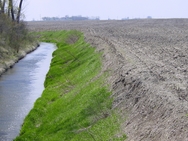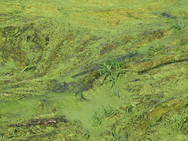|
June 2014
 The Le Sueur River Watershed Network is sponsoring a potluck and meeting 5:30-8:30 p.m. Thursday, June 26, at Pat and Kristin Duncanson’s farm, 57746 State Highway 30 in Mapleton. After the potluck, participants are invited to a discussion about future activities, starting possible conservation projects, and expanding the reach of this watershed group.
Pat Duncanson, watershed landowners and Mapleton residents will share lessons learned and the results of collaborations on the new County Ditch 57 in Mapleton which is designed to slow the water flow and filter the nutrients entering this ditch which drains into the Cobb River. A tour will follow of Mapleton’s new temporary water storage basin in CD 57 on Highway 30. The event is free and open to anyone interested in sharing a meal with neighbors and learning more about the Le Sueur River watershed or the emerging citizen-led watershed group, the Le Sueur River Watershed Network.
For more information about what local landowners in cooperation with local government and state agencies are doing, visit the Le Sueur River Watershed Network website. Pre-register by Monday, June 23, by e-mailing or calling: Anne Queenan, 651-659-0074; Jessica Nelson, 507-389-2704; or Becky and Don Waskosky, 507-388-2122.
Photo above shows a Le Sueur watershed meeting a year ago at Indian Island Winery near Janesville.
|
The Minnesota Pollution Control Agency (MPCA) is seeking proposals for projects that will reduce nonpoint source pollution in Minnesota’s lakes, rivers and streams. Funding for selected projects will be provided by the Federal Clean Water Act Section 319 (Section 319) grant funds.
Proposals must address nonpoint source development, education or applied research projects (DER) projects or implementation projects for Total Maximum Daily Load (TMDL) studies or Watershed Protection and Restoration Strategies (WRAPS). The MPCA anticipates about $2.5 million will be available this year, contingent upon Congressional appropriation.
There is a maximum limit of $300,000 per project funding request. Projects must be funded with at least a 45-percent local cash or in-kind match. Grant funds are limited and MPCA urges proposers to request only those funds needed to complete a project by Aug. 31, 2018. For TMDL/ WRAPS implementation projects, eligible proposers must have a TMDL Implementation Plan or WRAPS approved by the MPCA by June 30, 2014.
The complete Request for Proposal (RFP), proposal form, and other information is available on the state SWIFT e-supplier portal. Prospective responders must have a SWIFT Vendor ID and Supplier Portal Account set up to apply. Please note that it can take up to four days to receive your vendor ID from SWIFT. If you need assistance registering in the Supplier Portal so you can bid on this solicitation, you may contact the Minnesota Department of Administration, Materials Management Division at 651-201-8100, option 1. Then follow the prompts to connect you to the correct contact person.
Proposals must be electronically received through the state SWIFT Supplier Portal no later than 2 p.m. Friday, July 11. Submissions received after the deadline will not be eligible for consideration. Successful proposers will be notified around Aug. 1 and will then be required to submit a detailed work plan, budget and timeline/Gantt chart.
The date and all other information in this notice are subject to change and updates will only be found in the SWIFT Vendor ID and Supplier Portal Account.
Questions may be e-mailed to Contracts.pca@state.mn.us, Attention: Julianne LaClair.
The University of Minnesota will hold two workshops in July on new computer tools to support decision-making for Best Management Practices (BMPs) and priorities when working to reduce pollutants in lakes and streams. Funded by a Section 319 grant from the Minnesota Pollution Control Agency (MPCA), these three tools are designed for natural resources and watershed professionals:
- Economic tool to rapidly estimate BMP costs;
- Model of hydrologic and water quality impacts; and
- Channel restoration prioritization tool.
The three workshops will be held in two locations, and are open at no charge to people assisting landowners in establishing BMPs to improve water quality:
- Tuesday, July 1, from 1-4 p.m. at Southwest State Minnesota University in Marshall (computer lab, BA 229 and 230)
- Tuesday, July 8, from 8 a.m.-noon at South Central College in Mankato (computer lab, C160)
- Tuesday, July 8, from 1-4 p.m. at South Central College in Mankato (computer lab, C160)
Pre-registration is requested, contact Kathy Eckwright, eckwr001@umn.edu or 507-389-6972.
Detailed descriptions of the tools:
-
Economics Tool: This economic tool seeks to will rapidly estimate BMP implementation costs prior to installation, based on aggregating past costs of similar BMPs. The tool allows a user to estimate costs based on region, and to see how scaling up the size of the BMP installation may or may not have an effect on the per-unit cost of the BMP. The goal is to effectively target scarce conservation dollars in more cost-effective ways.
-
Model of Hydrologic and Water Quality Impacts: This ArcGIS tool estimates at a 40-acre field scale the current non-point source pollution and then reductions from implementing select BMPs. The pollutants evaluated are nitrate, phosphorus and sediment. This tool will also assess priority areas and test different BMP implementation scenarios.
-
Channel Restoration Prioritization Tool: Clean water goals in Minnesota require the reduction of sediment and nutrient loading from upland as well as streambanks and riparian corridors. A combination of tools has been developed with funding both from Section 319 and Minnesota Dept. of Agriculture Clean Water Research programs. Using GIS, field investigations and LiDAR analysis, natural resources and watershed professionals can select specific sites for BMPs.
The University of Minnesota Extension will host two workshops on how perennial plantings/systems can improve water quality:
- Fairmont, June 24
- Glenwood, July 16
The workshops are designed to help farmers and landowners, including natural resource professionals, implement perennial plantings that would improve water quality and achieve other ecosystem services such as improved soil health and wildlife. Each day-long workshop will include presentations by local professionals, University Minnesota Extension faculty and University of Minnesota researchers.
Workshop details available on the Extension website. These workshops will also review the tools referenced above.
 Biological stressor identification reports and summaries for the Yellow Medicine and Hawk Creek watersheds are now available on their MPCA watershed webpage.
Although the watersheds comprise a single Hydrologic Unit Code (07020004), and they share many characteristics, they are represented by separate organizations, and differ in some respects. The Yellow Medicine tumbles from the high prairie coteau in western Lincoln County. Hawk Creek begins at a leisurely pace from a chain of lakes around Willmar. Both rivers knife down through the prairie, creating 100-foot-tall or more banks before entering the Minnesota River – the Yellow Medicine in Upper Sioux Agency State Park on the south, and the Hawk from the north about one-third mile downriver.
As they enter the prairie cropland en route to the Minnesota River, they encounter similar stresses:
- Altered hydrology from ditching and tile drainage (photo above shows a ditch bank in the watershed);
- High phosphorus and nitrates;
- Sediment;
- Low dissolved oxygen; and
- Loss of habitat.
These combine in varying degrees to reduce their Index of Biotic Integrity scores – a health measure of fish, insects, and other aquatic organisms. The reports provide a detailed account of causes of biological stressors, but more monitoring will be needed to get a better understanding of the stressors.
Recommendations for reducing biological stressors include:
- Landscape changes that reduce rates and volume of runoff;
- Increasing riparian buffers;
- Crop nutrient management; and
- Stabilizing streambanks.
Much of the monitoring and implementation work is being done by the Yellow Medicine River Watershed District, and Hawk Creek Watershed Project.
|
The MPCA recently released a video program, "Stream gets a check-up," which explains the biological monitoring efforts underway across the state. The agency encourages watershed districts, SWCDs and other local partners to show this video to their governing boards and at kickoff meetings for intensive water monitoring in their watersheds. In the program, which is less than 5 minutes long, MPCA research scientist Mike Feist explains how examining fish and bugs is like a health checkup for rivers.
 The University of Minnesota is one of 12 land grant universities to partner with the federal task force working to reduce nutrients in the Mississippi River and Gulf of Mexico. The task force recently announced this partnership to support state-level strategies and actions to curb water pollution. The Hypoxia Task Force is a partnership of five federal agencies, tribes, and environmental quality, agricultural, and conservation agencies from 12 basin states working to address nutrient pollution and the hypoxic zone, or dead zone in the Gulf of Mexico.
The other universities are: Purdue University, University of Illinois, University of Arkansas, University of Kentucky, Mississippi State University, Ohio State University, University of Tennessee, University of Missouri, University of Wisconsin, Iowa State University and Louisiana State University.
The universities are already conducting research on issues like soil conservation, water quality and how nutrients like nitrogen and phosphorus travel in water bodies. University scientists and policy experts are working to put science into practice by providing educational programs for farmers, local businesses, and conservation and watershed management professionals. This new network will bring additional expertise to help reduce nutrient runoff and advise the task force and other national policy makers.
Nutrient pollution is one of America's most widespread, costly and challenging environmental problems, and is caused by excess nitrogen and phosphorus in the air and water. The impacts of nutrient pollution are found in all types of water bodies. More than 100,000 miles of rivers and streams, close to 2.5 million acres of lakes, reservoirs and ponds, and more than 800 square miles of bays and estuaries in the United States have poor water quality because of nutrient pollution.
In Minnesota, the MPCA continues to prepare its draft Nutrient Reduction Strategy for submission to the U.S. Environmental Protection Agency for approval.
|
|